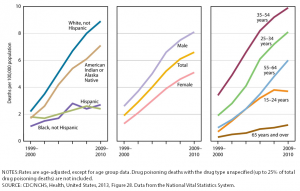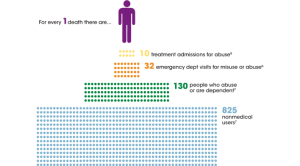Opioid abuse and resulting drug addiction have become such an issue that presidential candidates are talking about it. It is becoming much more prevalent and has even hit close to home last year with the bust of a heroin ring on the Northshore of Lake Pontchartrain. A discussion about it this week on NPR’s On Point described this kind of addiction as a disease in itself. A young man called in, Tom, stating he was a recovering heroin abuser, currently receiving regular methadone doses at a clinic. He said it started when he injured his back at work. He went on to describe the progression from injury to addiction, “From there you got to have them everyday to function at work and it gets to a point where actually you don’t even care about the high anymore, you just don’t want to get sick. Then the time comes and somebody offers you heroin.” The show talked about how the market for heroin has increased because of people that have become addicted to opioid pain killers, like hydrocodone, Vicodin, and Percocet. Fortunately for Tom, he was able to recognize his problem and receive treatment. Others are not so fortunate and waste their lives away before dying.
Where does the drug addiction start? It starts with prescribing the medication and many times it is prescribed for a musculoskeletal pain, like Tom’s. Want a solution to this rampant problem? The answer is physical therapy. Physical therapy is an effective treatment for a host of pains, including back pain, for which these medications are commonly prescribed. Physical therapy as a treatment is not prescribed nearly as much or as quickly as it should be. Physical therapy is effective in treating back pain, especially within two weeks of onset. Research has shown earlier PT can decrease the prescription of opioid medications by 78%. Other benefits include decreased surgery by 45%, decreased advanced imaging by 34%, and decreased injections by 42%. The earlier, the better, when it comes to starting therapy.
The costs of opioid addiction are high and devastating.
As a physical therapist, it is frustrating to hear stories like Tom’s, even from my own patients who were not prescribed physical therapy first. For people with pain, get physical therapy first. Let’s get this message out to more people so they know to ask for effective, non-pharmacologic treatments. It’s the way it should be.
References
- Fritz, Julie M., et al. “Primary care referral of patients with low back pain to physical therapy: impact on future health care utilization and costs.” Spine37.25 (2012): 2114-2121.
- Choi, B. (2011). Exercises for prevention of recurrences of low-back pain. Cochrane Database of Systematic Reviews. [serial online]. January 18,2011;(2) Available from Cochrane Database of Systematic Reviews, Ipswich, MA. Accessed July 7, 2014.
- “Policy Impact: Prescription Painkiller Overdoses, What’s the Issue” (2013). Centers for Disease Control. http://www.cdc.gov/homeandrecreationalsafety/rxbrief/
- Health, United States, 2013 (2013). Centers for Disease Control, Natl Center for Health Statistics. http://www.cdc.gov/nchs/hus.htm












January 23, 2016
Orthopaedic, Prevention